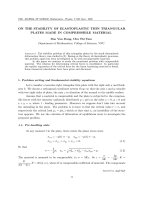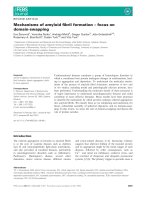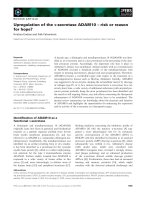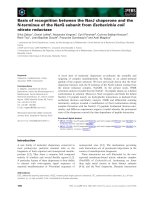Tài liệu Báo cáo " ON THE STABILITY OF ELASTOPLASTIC THIN TRIANGULAR PLATES MADE IN COMPRESSIBLE MATERIAL " doc
Bạn đang xem bản rút gọn của tài liệu. Xem và tải ngay bản đầy đủ của tài liệu tại đây (183.68 KB, 11 trang )
VNU. JOURNAL OF SCIENCE, Mathematics - Physics. T.XXI, N
0
4 - 2005
ON THE STABILITY OF ELASTOPLASTI C THIN TRIANGULAR
PLATES MADE IN COMPRESSIBLE MATERIAL
Dao Van Dung, Chu Thi Tam
Department of Mathematics, College of Sciences, VNU
Abstract. The stability problem of thin triangular plates by the small elastoplastic
deformation theory, was studied in [3]. Basing on the theory of elastoplastic processes,
this problem again has been investigated in [4] with incompressible material.
Inthispaperwecontinuetostudythementioned problem with compressible
material. The relation for determining critical forces is established. In particular
the explicit expression of the critical force for the linear hardening material is found.
Some numerical calculations have been given and discussed.
1. Problem setting and funda mental stability equations
Let’s consider a isosceles right triangular thin plate with the right side a and thick-
ness h. We choose a orthogonal coordinate system Oxyz so that the axis x and y coincide
with two right sides of plate, the axis z in direction of the normal to the middle surface.
Assume that a material is compressible and the plate is subjected to the compress-
ible forces with the intensity uniformly distributed p = p(t) at the sides x =0,y =0and
x + y = a,wheret - loading parameter. Moreover we suppose don’t take into account
the unloading in the plate. The problem is to have to find the critical value t = t
∗
and
respectively the critical load p
∗
= p(t
∗
) which at that time t
∗
an instability of the struc-
ture appears. We use the crirerion of bifurcation of equilibrium state to investigate the
proposed problem.
1.1. Pre-buckling state
At any moment t in the plate, there exists the plane stress state
σ
xx
= −p(t) ≡−p, σ
yy
= −p(t) ≡−p,
σ
xy
= σ
xz
= σ
yz
= σ
zz
=0. (1.1)
So that
σ = −
2
3
p; σ
u
=
σ
2
xx
+ σ
2
yy
− σ
xx
σ
yy
= p. (1.2)
The material is assumed to be compressible, i.e σ =3Kε.Soε =
σ
3K
= −
2p
9K
, K =
E
3(1 − 2ν)
, E =2G(1+ν), where K is compressible coefficient of material. The components
Typeset by A
M
S-T
E
X
14
On the stability of elastoplastic thin triangular plates made in 15
of the strain velocity tensor detemined by the stress-strain relationship of elastoplastic
process theory [1, 7] are of the form
˙ε
xx
= ˙ε
yy
= −
p
1
2φ
+
2
9K
Q
˙p, ˙ε
xy
= ˙ε
yz
= ˙ε
xz
=0,
˙ε
zz
=
p
1
φ
−
2
9K
Q
˙p; φ
= φ
(s), (1.3)
where s is the arc-length of the strain trajectory calculated by the formula
ds
dt
=
√
2
3
( ˙ε
xx
− ˙ε
yy
)
2
+(˙ε
yy
− ˙ε
zz
)
2
+(˙ε
zz
− ˙ε
xx
)
2
=
1/2
=
˙p
φ
(s)
or φ
(s)ds = dp .
That yields
p = σ
u
= φ(s), (1.4)
or with the hardening material, s = φ
−1
(p).
nn1.2. Post-buckling state
At the moment an instability occurs, a bifurcation of equilibrium states is assumed
to appear. T he system of stability equations of the compressible thin plates presented in
[7]iswritteninformasfollows
α
1
∂
4
δw
∂x
4
+ α
3
∂
4
δw
∂x
2
∂y
2
+ α
5
∂
4
δw
∂y
4
+
9p
h
2
N
p
∂
2
δw
∂x
2
+
∂
2
δw
∂y
2
Q
=0. (1.5)
where
α
1
= α
5
=
1
C
p
1
4
+
3φ
4N
+
φ
9K
Q
; α
3
=
1
C
p
1
2
+
3φ
2N
−
2φ
9K
Q
,
N =
σ
u
s
=
p
s
,C=1+
4φ
9K
, φ
= φ
(s). (1.6)
1.3. Boundary conditions
We consider the thin plate with the simply supported boundary conditions. In this
case we have
δw =0,
∂
2
δw
∂x
2
=0, at x =0,
δw =0,
∂
2
δw
∂y
2
=0, at y =0,
δw =0,
3φ
C
(∆δw)+2N
∂
2
δw
∂x∂y
=0, at x + y = a. (1.7)
16 Dao Van Dung, Chu Thi Tam
2. Solving method
We choose the deflection δw satisfing the boundary condition (1.7) in the form
δw = A
mn
sin
mπx
a
sin
nπy
a
+(−1)
m+n+1
sin
nπx
a
sin
mπy
a
=
, (m, n ∈ N
+
; m = n)(2.1)
Calculating partial derivatives of δw and substituting those expressions into the stability
equation (1.5) and taking into account the existence of non-trivial solution i.e A
mn
=0,
we receive the expression
α
1
p
mπ
a
Q
4
+ α
2
p
mπ
a
Q
2
p
nπ
a
Q
2
+ α
5
p
nπ
a
Q
4
−
9p
Nh
2
(m
2
+ n
2
)
π
2
a
2
=0. (2.2)
By putting i =
3a
h
(called the slenderness of the plate) and α
1
= α
5
, the relation (2.2)
becomes
i
2
=
9a
2
h
2
=
Nπ
2
p
α
1
(m
2
+ n
2
)
2
+(α
3
− 2α
1
)m
2
n
2
m
2
+ n
2
· (2.3)
Substituting the values of α
1
and α
3
into (2.3) we get
i
2
=
9a
2
h
2
=
π
2
s
1
C
p
1
4
+
3φ
s
4p
+
φ
9K
Q
(m
2
+ n
2
) −
4φ
m
2
n
2
9KC(m
2
+ n
2
)
=
. (2.4)
This equation (2.4) permits us to determine a critical load p
∗
. Because of the force p is
non-linear function of s, then the relation (2.4) is too non-linear to s.
We can solve this equation by using the modified elastic solution method [2].
First of all, choosing m =1,n = 2, the equation (2.4) can be rewritten in the other
form
s =
5π
2
4
p
h
a
Q
2
p
1+
3sφ
φ
Q
K
9K +4φ
+
π
2
5
p
h
a
Q
2
·
φ
9K +4φ
(2.5)
or
s =
5π
2
4
p
h
a
Q
2
1+3
E
t
(s)
E
c
(s)
=
K
9K +4E
t
(s)
+
π
2
5
p
h
a
Q
2
E
t
(s)
9K +4E
t
(s)
, (2.6)
where E
t
(s)=φ
(s) - the tangential modulus, E
c
(s) - the secant modulus of the material.
The problem determining critical loads of a plate reduces to seek the critical value s
∗
.
Finally the critical load can be found from
p
∗
= φ(s
∗
). (2.7)
Now we presente in detail this iterative method.
On the first iteration by putting E
c
(s)=E
t
(s)=3G, from (2.6) we get
s
1
=5π
2
p
h
a
Q
2
K
9K +12G
+
π
2
5
p
h
a
Q
2
G
3K +4G
· (2.8)
If s
1
a ε
s
(elastic limit), the iteration is finished and the critical force is given by
p
(1)
∗
=3Gs
1
=5Gπ
2
p
h
a
Q
2
K
3K +4G
+
3π
2
5
p
h
a
Q
2
G
2
3K +4G
· (2.9)
On the stability of elastoplastic thin triangular plates made in 17
If s
1
> ε
s
, we proceed to the second iteration by the formula
s
2
=
5π
2
4
p
h
a
Q
2
1+3
E
t
(s
1
)
E
C
(s
1
)
=
K
9K +4E
t
(s
1
)
+
π
2
5
p
h
a
Q
2
E
t
(s
1
)
9K +4E
t
(s
1
)
· (2.10)
The calculations are realized analogously as the first iteration.
A procedure of the iterative method for solving the relation (2.6) can be written as
following
s
n
=
5π
2
4
p
h
a
Q
2
1+3
E
t
(s
n−1
)
E
c
(s
n−1
)
=
K
9K +4E
t
(s
n−1
)
+
π
2
5
p
h
a
Q
2
E
t
(s
n−1
)
9K +4E
t
(s
n−1
)
(2.11)
and the critical force for n-th iteration, is determined by
p
(n)
∗
= φ(s
n
), (2.12)
where s
n−1
is considered to be known at (n − 1)-th iteration.
Practically, the iterative process will be finished when
e
e
e
s
n
− s
n−1
s
n−1
e
e
e
< ε, (2.13)
where ε is a given forward positive and small value.
3. Linear hardening material
The general case for hardening material is presented in the above part, now we
consider the problem for linear hardening material.
3.1. If the function σ
u
= φ(s) is represented by graph in figure 1.
In this case we have φ
= g =const,σ
u
= p =3Gs
0
+(s − s
0
)g.Itisseenfrom
here that
s =
p −(3G −g)s
0
g
≡
p − λ
g
(3.1)
where λ =(3G −g)s
0
=
p
1 −
g
3G
Q
σ
s
;0a λ a σ
s
, σ
s
is an upper limit of elastic stress.
Figure 1
18 Dao Van Dung, Chu Thi Tam
Substituting the expression of s from (3.1) into (2.4), we obtain the equation for
finding the critical force p as follows
36a
2
p
2
−
+
36λa
2
+
4gπ
2
h
2
C
2
(m
2
+ n
2
)
1+
g
9K
p
m
2
− n
2
m
2
+ n
2
Q
2
=
p
+
3h
2
π
2
gλ
C
(m
2
+ n
2
)=0. (3.2)
Putting the left side of (3.2) equal to f(p), we notice that f(p) i s the continuous function to
s and f(λ) a 0. So that the equation (3.2) gives us two solutions satisfying the conditions
p
1
a λ a p
2
. Solving the equation (3.2), finally we ha ve
p =
1
18a
2
l
9λa
2
+
gπ
2
h
2
C
(m
2
+ n
2
)
1+
g
9K
p
m
2
− n
2
m
2
+ n
2
Q
2
=
+(3.3)
+
9λa
2
+
gπ
2
h
2
C
(m
2
+ n
2
)
1+
g
9K
p
m
2
− n
2
m
2
+ n
2
Q
2
=
2
−
27π
2
h
2
gλa
2
C
(m
2
+ n
2
)
M
.
Remarks
+ If material is elastic i.e g =3G, the expression (3.3) becomes
p =
π
2
G
3C
(m
2
+ n
2
)
h
2
a
2
1+
G
3K
p
m
2
− n
2
m
2
+ n
2
Q
2
=
(3.4)
+ If material is incompressible i.e K →∞, the expression (3.3) is given
p =
1
18a
2
+
9λa
2
+ gh
2
π
2
(m
2
+ n
2
)
+
J
9λa
2
+ gh
2
π
2
(m
2
+ n
2
)
o
2
− 27gπ
2
h
2
λa
2
(m
2
+ n
2
)
. (3.5)
Deduces from here
p
∗
=minp = p
e
e
m
2
+n
2
=5
=
1
18a
2
+
9λa
2
+5gπ
2
h
2
+
0
(9λa
2
+5gπ
2
h
2
)
2
− 135g λa
2
π
2
h
2
. (3.6)
This result coincides with one presented in [4].
3.2. If the function σ
u
= φ(s) is represented by graph in figure 2.
We have
σ
u
= σ
s
+(s
1
− s
0
)tgα
1
+ ···+(s
k−1
− s
k−2
)tgα
k−1
+(s − s
k−1
)tgα
k
=3Gs
0
+
k−1
3
i=1
(s
i
− s
i−1
)g
i
+(s − s
k−1
)g
k
, (3.7)
On the stability of elastoplastic thin triangular plates made in 19
where s
0
=
σ
s
3G
; g
i
=tgα
i
= φ
(s)withs
i−1
a s a s
i
; i = 1,k− 1; g
k
=tgα
k
= φ
(s)
with s s
k
.
Because σ
u
= p, so (3.7) leads
p =(3G −g
1
)s
0
+
k−1
3
i=1
(g
i
− g
i+1
)s
i
+ g
k
s. (3.8)
Figure 2
Deduces from here
s =
p −
(3G −g
1
)s
0
+
k−1
i=1
(g
i
− g
i+1
)s
i
=
g
k
≡
p − λ
g
k
, (3.9)
where
λ =(3G −g
1
)s
0
+
k−1
3
i=1
(g
i
− g
i+1
)s
i
.
Substituting (3.9) into (2.4) and calculating analogously as the part 3.1, we get
p =
1
18a
2
l
9λa
2
+
g
k
π
2
h
2
C
(m
2
+ n
2
)
1+
g
k
9K
p
m
2
− n
2
m
2
+ n
2
Q
2
=
+ (3.10)
+
9λa
2
+
g
k
π
2
h
2
C
2
(m
2
+ n
2
)
1+
g
k
9K
p
m
2
− n
2
m
2
+ n
2
Q
2
=
2
−
27π
2
h
2
g
k
λa
2
C
(m
2
+ n
2
)
M
.
This is the relation for determining the critical force p
∗
.Itisseenthatifg
1
= g
2
= ··· =
g
k
= g, the expression (3.10) returns to the result (3.3).
20 Dao Van Dung, Chu Thi Tam
4. Numerical calculations and discussion
4.1. Linear hardening material
We co nsider a plate with the characteristics as follows 3G =2.6 · 10
5
(MPa), σ
s
=
400 (MPa), φ
(s)=g =0.208 · 10
5
(MPa), m, n from1to10(m = n). The r atio
a
h
varies
from 22 to 49 with the arithmetical ratio equal to 3, K =
E
3(1 −2ν)
, E =2G(1 + ν), ν
from 0.20 to 0.50 with arithmetical ratio equal to 0.04. We use the formula (3.3).
Hereafter we give the numerical results which are represented by graphs
a) Plastic σ
∗
u
and elastic σ
∗
u
in the cases ν =0.2(table3,figure 3)
b) Plastic σ
∗
u
and elastic σ
∗
u
with ν =0.44 (table 4, figure 4)
c) Plastic σ
∗
u
and elastic σ
∗
u
with ν =0.5(table5,figure 5)
Table 3
a/h σ
∗
u
(plastic)(MPa) σ
∗
u
(elastic)(MPa)
22 455.571 2972.747
25 429.571 2303.095
28 413.315 1835.216
31 403.517 1497.200
34 396.405 1244.644
37 391.282 1050.993
40 387.462 899.255
43 384.531 778.156
46 382.229 679.967
49 380.386 599.254
Figure 3
On the stability of elastoplastic thin triangular plates made in 21
Table 4
a/h σ
∗
u
(plastic)(MPa) σ
∗
u
(elastic)(MPa)
22 461.854 2950.319
25 433.693 2284.473
28 416.628 1821.370
31 405.552 1485.905
34 397.952 1235.255
37 392.500 1043.063
40 388.447 892.471
43 385.345 772.285
46 382.915 674.837
49 380.972 594.733
Figure 4
22 Dao Van Dung, Chu Thi Tam
Table 5
a/h σ
∗
u
(plastic)(MPa) σ
∗
u
(elastic)(MPa)
22 436.246 2945.474
25 434.589 2280.975
28 417.244 1818.379
31 406.000 1483.456
34 398.292 1233.226
37 392.767 1041.351
40 388.662 891.006
43 385.532 771.016
46 383.064 673.728
49 381.099 593.756
Figure 5
4.2. Hardening material
We consider a plate made of the stell 30XΓCA with an elastic modulus 3G =
2.6 · 10
5
MPa, an yield point σ
u
= 400 MPa and the table de dates given in [1]. The
Poisson coefficient is equals to 0.2; 0.32; 0.44. The calculations are realized by the formu la
On the stability of elastoplastic thin triangular plates made in 23
(2.6) and the iterative method represented in part 2. Finally we receive the results in the
table 6 and the figure 6.
Table 6
a/h σ
∗
u
(ν =0.2) σ
∗
u
(ν =0.32) σ
∗
u
(ν =0.44)
22 531.498 544.375 568.888
25 511.295 528.059 544.254
28 497.993 510.571 529.782
31 481.474 498.883 515.507
34 466.801 485.054 502.241
37 451.065 472.045 489.882
40 435.384 456.226 476.926
43 407.437 444.688 466.564
46 367.182 426.108 452.499
49 323.597 397.762 443.272
Figure 6
Discussion
The above received results lead us to some remarks as follows
a) The more the plate is thin, the more the value of critical stress i ntensity σ
∗
u
is
small (see Figures 3, 4, 5, 6).
24 Dao Van Dung, Chu Thi Tam
b) The compressibility of material has an influence on the stabilit y of structure.
ThemorethePoissoncoefficient ν decreases,themorethevalueofσ
∗
u
diminishes when
the ratio
a
h
is constant . This remark is d educed from the results in Table 6 and Figure 6.
c) When a material is incompressible, the obtained results return to the previous
well-knownones(see[3,4,5,6,8]).
This paper is completed with financial support from the National Basic Research
Program in Natural Sciences.
References
1. Dao Huy Bich, Theory of elastoplastic processes, Vietnam Univ ersity Publishing
House, Hanoi 1999 (in Vietnamese).
2 Dao Huy Bich. Modifiedelasticsolutionmethodinsolving elastoplastic problems
of structures subjected to complex loading, Vietnam Journal of Mech., NCST of
Vietnam, Vol 22, No 3(2000), pp. 133-148.
3. Nhu Phuong Mai and Hoang Si Tuan, Elastoplastic stability of triangular layered
plates, Proceedings of the 7
th
national congress on Mechanics, Hanoi, 12-2002, pp.
373-379.
4. Dao Van Dung, Elastoplastic stability of triangular plates subjected to the com-
pressible forces with the simply supported boundary condition, Proceedings of the
seventh national conference on deformable solid mechanics, Doson 27-28, August,
2004, pp. 129-137 (in Vietnamese).
5. Volmir A. S, Stability of deformable systems, Moscow, 1967 (in Russian).
6. Hill R, Plastic deformation and instability in thin-Walled turber under combined
loading: a general theory, Journal of Mech. of Solids, 47(1999), pp. 921-933.
7. Dao Van Dung, Stability of thin plates with compressible material according to the
theory of elastoplastic processes, Journal of Mech., Vol 17, No 1(1995), pp. 15-21.
8 Willis. J.,Stability of media and stru ctures, Ecole Polytechnique P alaiseau, 2000.









